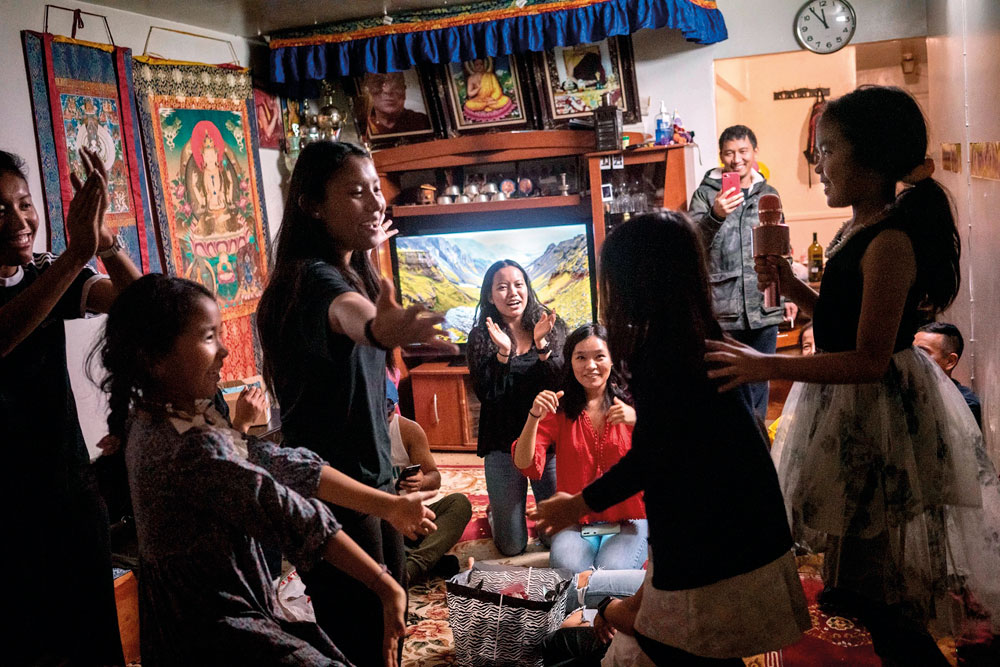The latest Seke language outbreak in Brooklyn
- Seke is one of the languages of the Mustang region in Nepal and currently has only about 700 speakers. All the criteria indicate that it is in serious danger of extinction, although in recent years attempts are being made to survive a fire in a New York building.

Mustang, the former kingdom located north of Nepal, taking advantage of the passage of Kora La, which “is only 4,660 metres” to cross the Himalayas, has historically been a step towards trade between Tibet and India. The history of this kingdom alternates legends with real facts. Its foundation is based on the hearts and bowels of the devil who was killed by a Buddhist monk in 1380 and, although he maintained strong ties with Tibet, functioned for centuries as an independent kingdom. In 1795, when Nepal annexed its lands, it lost sovereignty, even though the king of Mustan maintained several powers. Due to the recent political changes in the area, in 2008, when all of Nepal became a republic, the king lost his crown and his powers.
Inside the isolated Mustang is a more isolated region, called the Upper Mustang. There, nothing happens, well, sometimes yes, for example, in the 1960s, when it became the base of Tibetan guerrillas supported by the CIA to fight the occupation of communist China. Years later, President Richard Nixon of the United States visited China and dismantled these gift guerrillas. The Cold District War calmed down. Five decades after these events, in Mustang Superior, there's been another kind of temple, the climate one. Harvests are becoming increasingly scarce and for many people emigration is the only way forward.
They have difficulty understanding each other
Among those who emigrate or occur, are the inhabitants of Chuksang, Chaile, Gyakar, Tangelbe and Tetang, the users of the Seke language. Seke means “golden language” and is located in the Tamangic branch of the F-tibetan family. It's an unwritten language, without any literary tradition. As for the most optimistic numbers, the fact that there are only 700 speakers, that there are three different dialects and that they have difficulty understanding each other is highlighted. It has remained for communication between the elderly, as young people prefer nepal, either because they receive it in school or because they expand their work possibilities. When choosing the second language, betting on English or Hindi are the main ones. Migrations from studies or work to cities like Pokhara or Kathmandu are frequent, and in these situations there is only a recent memory of Seke. Given that in the world a language disappears every two weeks, thinking that it will soon be on that checklist would not be crazy.
If we talk about language survival, mass migration is bad news, but occasionally, nice unforeseen stories emerge, and secession is one of them. The numbers of the Endangered Language Alliance (ELA) in the streets and houses of New York speak 637 languages. In the Brooklyn district, there is the Ditmas Park district, where about 100 seclars live, 50 of them in the same building. Most were farmers or farmers in Mustang Superior, while in North America they are manicurists, construction workers or cooks. Their apartments are filled with memories of Nepal. Around the walls you can see wooden benches covered with carpet and on the walls tools of the original house or photographs of the Dalai Lama. Odors are also special: spices, incense and teas are mixed and momo is the traditional food that has led to America, and that prepare the holidays. The gigantic plasma television is one of the few concessions it has given to Western modernity.
In this environment, they've created the breathing space of the sections, almost involuntarily, almost inadvertently. In their villages, face-to-face communication was not easy, as it takes days to go from one people to another and it is difficult to find interlocutors. In Brooklyn, to be able to work in your language, you only need a 10-second elevator ride.
Not everyone has lost hope
One of the main responsibility for this context is Rasmina Gurung, a 22-year-old nurse and, according to her words, the youngest of talking sacks. The responsibility for the survival of his language has been taken with enthusiasm, but he often has a sense of alarm, anger, sadness and despair.
He says that the neighborhood has changed, that before the ethnic or cultural communities were closed. It was difficult, for example, to marry between Italian Catholics and Irish Catholics. Today the mixture is larger, which has many positive differences, but it is not good news for the future of the sections.
In the Ditmas Park building there are five villages in Mustange Alta, so it is difficult to understand between the dialects, some speak of tangles, others of tetang and the rest of chuksang. They have also created a common seke to improve communication, using relevant words of each type. As mentioned above, it is an unwritten language, and to help overcome this difficulty, Rasmina Gurung, with the help of ELA, is creating in recent months an English dictionary. To transcribe words, for example, it uses the Latin alphabet and does not find the most appropriate one when expressing many sounds. Even when abstract words are translated, the word soul, for example, is not the same in Nepali culture as in Anglo-Saxon.
It's also collecting video recordings that have been broadcast through channels like YouTube, but it has a time-wrestling distrust, which is just a prolongation of agony. Gurunge has the invaluable help of his ancestors, but he doubts that futures will appreciate the result of his effort. Young people learn and work in English, live in English and then try to master Spanish or Mandarin Chinese, thinking that they can be useful to improve their living or working conditions. Seke, like the mountains of Upper Mustan, is far too far away.
In the ALS criteria, the risk of tongue loss begins when the population is less than 10,000 speakers. Seke's 700. All the evidence suggests that, at present, it should have disappeared, but even though the Brooklyn respiratory zone is short-term, it has given the bellows to the language. Weak bellows, though. Immigrants have long days and little time to be with children. The Government of Nepal does not take minority languages into account, so there are no cultural or language centres. Ensuring transmission is becoming more and more difficult. Experts say Seke may be between ten and fifteen years old, but thanks to people like Rasmina Gurung there is not only a written and recorded testimony, but also a hope.










